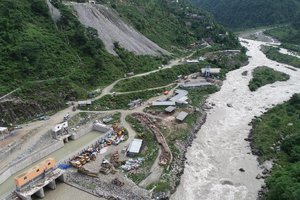Opinion

Widened Gender Disparity In Education
According to a report by the World Economic Forum in 2020, educational attainment gaps has narrowed down across the world with 35 countries achieving 100 percent parity and 120 countries reducing their educational gap by at least 95 percent.
By Novela Acharya Sep 16, 2020
Why We Need Smarter, Targeted Subsidies To Promote Solar Irrigation?
They are superior to diesel pumps as they only require sunlight for fuel, have limited maintenance costs, and are lighter and easier to maneuver in Nepal’s rough terrains.
By Labisha Uprety and Dr. Vishnu Prasad Pandey Sep 10, 2020

Addressing Water Security In The South Asian Region Through Nexus Governance
Most of the water security studies in Nepal have been context-specific. Some studies have focused on a farmer-managed irrigation system, some have focused on hydropower potentiality and some based on agricultural insecurity
By Pratik Poudel Sep 08, 2020

Covid Uncertainties, Technical Authoritarianism & Philosophical Qualms
This is where Covid science as currently practiced completely fails me and all who may come into contact with me. First, lockdown, i.e. converting my home into a hospital ICU and me and family members as its patients work only for the upper and upper-middle class and only for the isolation period, which itself is difficult to maintain.
By Dipak Gyawali Sep 02, 2020
Boons And Curses: The Legend Of The Mythological Mother
Mother and child is the basic unit of human society, rest all is socially constructed. Naturally, world of literature and art is replete with the energy and possibilities that such a primal source material provides.
By Dhiraj Singh Aug 31, 2020

Avoidable Disasters
The tragedy happened despite the fact that those who lost their lives were aware of the risks. Several months ago, they had noticed cracks along the hill slopes and reported to the government agencies in the district as well as their headquarters in Kathmandu
By Ngamindra Dahal, PhD and Hemant Ojha, PhD Aug 25, 2020

Conservation Through Financial Institutions
The International Finance Corporation (IFC), the World Bank Group, has released a report on 'Cumulative Impact Assessment and Management: Hydropower Development in the Trishuli River Basin (TRB), Nepal' in July 2020. It may be the first CIA study report in Nepal.
By Batu Uprety Aug 21, 2020
Anglo- Nepal War 1814-16 And Causes
It has already been mentioned that the expansion of Nepal’s territory to the southwest was the first reason for the rivalry of the English towards Nepal. The second reason was that Nepal obstructed the trade route to Tibet and China.
By Prem Singh Basnyat, PhD Aug 19, 2020
Locust Invasion In Nepal
Fall Armyworm (Spodoptera frugiperda) is now also damaging maize crops in the mid-hills of Nepal. Recently, the country recorded invasion of the desert locust (Schistocerca gregaria) damaging crops in over 1,000 hectares of cropland.
By PK Jha, Lalit Prasad Sah and R Muniappan Aug 18, 2020

World Humanitarian Day 2020: Significance And Importance
Humanitarian workers manage and develop emergency response programs, and typically operate in front line conditions, helping communities to rebuild their lives after disasters, to become more resilient to future crises, to advocate for their voices to be heard, and to build lasting and sustainable peace and development in areas hit by human or natural disasters.
By Dr.Prabin Manandhar Aug 17, 2020
Latest Updates
- Gelephu Roadshow 2025: Connecting India and Bhutan for Sustainable Development
- 9 hours, 58 minutes ago
- Embassy of Nepal in India and PHDCCI India-Nepal Centre Organised “India-Nepal Economic Cooperation Meet 2025
- 4 days, 10 hours ago
- Bhanu Jayanti being celebrated today
- 5 days, 20 hours ago
- Police Interrogate Two Monarchist Officials, Release Them After Written Commitments
- 6 days, 20 hours ago
- Spain’s Academia de la Diplomacia and Nepal’s The Diplomat Nepal Join Hands
- 1 week, 1 day ago
- Just being born in Nepal does not make one a Nepali: former King Gyanendra Shah
- 1 week, 4 days ago
- Siddhababa Tunnel Makes A Major Milestone
- 1 week, 5 days ago
- PM Oli Returns Home Attending UN FFD4 Summit
- 1 week, 6 days ago
- Journalist Pathak ordered to be released on bail of Rs 25,000
- 2 weeks ago
- Tik Talker Rama Basnet released on bail of Rs 30,000
- 3 weeks, 1 day ago







